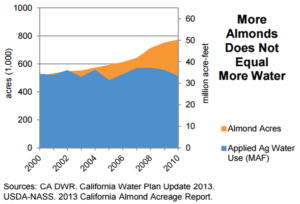Wonderful Almonds
While the mighty almond may be packed with protein and nutrition the average almond is also quite thirsty for our precious water resources, consuming 1.1 gallons of water for a single nut (2). As the tides rise, dwindling water supplies in California compete with the continued thirst for precious water resources by these delicious and nutritious treats. But, can California continue to balance the fight between its dwindling water supply and almonds hydration needs? The Almond Board of California and Paramount Farms, owner of Wonderful Pistachios & Almonds LLC, claim the industry has taken aggressive action towards bringing sustainability in almond production to the next level.
Who’s Drinking Our Water?
“Alarm as almond farms consume California’s water” (3) read one headline in the fall of 2014, as California suffered through a drought for another consecutive year. Many were asking where California’s water was going. The culprit, many claimed, was the almond nut. A widespread misbelief was that almond production single handedly consumed an astonishing 10% of California’s water (4). However, with a footprint of 14% of California’s irrigated farmland, almonds actually only consumed 9.5% of California’s agricultural irrigated water (4). While still a significant amount of water, the almond industry has actually made continuous efforts to reduce its water consumption and support sustainable growing.
Progress in Sustainable Production
With over 13 million trees (5) used to produce almonds and pistachios, Paramount Farming Co, owner of Wonderful Pistachios & Almonds LLC, is the world’s largest grower of nuts (6). The company recognizes the significance of sustainable agriculture and is highly sensitive to its water consumption levels. The company has invested almost $25m in research and development in the continuous improvement of water-efficient irrigation practices (7). Additionally, the Almond Board of California invests +$2m annually in researching production and environmental issues related to Almonds (4). These efforts are paying off as the almond has learned to be leaner on its water consumption. “Since the early 1990s”, claims the Almond Board of California, “advanced production practices have helped almond growers improve their water efficiency by 33%, producing more crop per drop” (4). As seen in the chart below, efforts towards more efficient almond production continues to be realized: More almond production does not necessarily have to mean more water consumption.
How is Water Efficiency Being Achieved?
Through progress in water distribution and advancements in monitoring technology, the almond industry has been able to enhance its distribution of resources required for almond production in order to more efficiently water and nourish almond trees. In fact, through these improvements, 83% of almond growers are now able to practice “demand-based irrigation”, whereby they have the ability to “track items like soil moisture, tree water status [and] weather conditions to determine when to irrigate their orchards rather than watering on a predetermined schedule” (4). This need based distribution monitoring helps to prevent wasteful use of resources. Additionally, 70% of almond orchards also now use micro-irrigation systems, which through drip technology and other direct irrigation advancements, helps to deliver water more efficiently to the root of the trees (4). This helps to reduce wasted water in areas where it never reaches the trees and helps to prevent water runoff (4).
The Real Question
Global warming is impacting people and places all over the world in different ways. As California stretches deeper into its multiyear drought, many have been asking where its water is going. While almonds are a meaningful consumer of California’s water supply, it is often overlooked how the State’s Almond Board and individual enterprises like Paramount Farming are investing the time, effort and resources in proactively establishing advancements in the production methods of almonds. Instead of blaming the almond for gulping up California’s precious water, maybe we should be applauding the industry’s efforts to reduce its relative water consumption and should rather be asking what other agricultural producers can be doing to increase the water efficiency of their produce. (657 words)
- Here’s the Real Problem With Almonds. Mother Jones. [Online] Mother Jones and the Foundation for National Progress. [Cited: 11 4, 2016.] http://www.motherjones.com/environment/2015/04/real-problem-almonds.
- Lurie, Alex Park and Julia. It Takes How Much Water to Grow an Almond?! Mother Jones. [Online] 2 24, 2014. [Cited: 11 4, 2016.] http://www.motherjones.com/environment/2014/02/wheres-californias-water-going.
- Rankin, Jennifer. Alarm as almond farms consume California’s water. The Guardian. [Online] 9 13, 2014. [Cited: 11 4, 2016.] https://www.theguardian.com/business/2014/sep/14/alarm-almond-farmers-drain-california-dry.
- Get Facts About Almonds and Water. Almonds.com. [Online] Almond Board of California. [Cited: 11 4, 2016.] http://www.almonds.com/get-facts-about-almonds-and-water?mobile=1.
- Sustainable Agricultural Practice. Wonderful Pistachios & Almonds. [Online] Wonderful Pistachios & Almonds LLC. [Cited: 11 4, 2016.] http://www.wonderfulpistachiosandalmonds.com/#sustainablefarming.
- 2013 Top Nut Growers. Growing Produce. [Online] [Cited: 11 4, 2016.] http://www.growingproduce.com/fruits/2013-top-nut-growers/.
- Water Stewardship. Wonderful Pistachios & Almonds. [Online] Wonderful Pistachios & Almonds LLC. [Cited: 11 4, 2016.] http://www.wonderfulpistachiosandalmonds.com/#waterstewardship.
- Almonds and Water 101. Almonds.com. [Online] Almond Board of California. [Cited: 11 4, 2016.] http://www.almonds.com/sites/default/files/misc/Cons/Documents/almonds_water_101_v2.pdf?mobile=1).





Great article, almonds are also very healthy which leads to less health problems in the US population. This leads to lower health care costs and therefore more money to be spent on investing in new sources of water, a win-win for everyone.
I was shocked after reading this at how much water almonds consume. While the headlines may have exaggerated the true consumption, 9.5% consumption for one (seemingly tiny) food product is alarming. As we discussed in the Planters case, almonds are seen as the “trendy, nutritious nut.” It is interesting to hypothesize what would have been the environmental impact if the pistachio or the peanut had instead been the “trendy” nut and seen an uptick in consumption. It is encouraging that Paramount is instituting sustainable practices to drive down the water consumption. I wonder if these practices can be applied more broadly to other types of nuts or high-consumers of water.
Almonds have become something of a “super” food in recent years due to their nutritional value and health benefits. If I am interpreting things correctly, the technology and techniques described in this post for reducing water usage when growing almonds have similarities to the hydroponics that are used to grow crops in greenhouses. Given the importance of almonds as a high value crop that can only be grown in a very limited number of locations across the world (within the US, only California), it will be important to find ways to reduce the environmental impact of their production.
Very interesting article, and love the almond picture. Surprising stat about a single nut’s water consumption. It is clearly noticeable that water availability will pose significant challenges to people nutritionally as a result of climate change. It is encouraging to see enterprises such as Paramount Farming are investing and leveraging innovative technologies to make positive impact related to this issue and wish other companies would follow suit. I am curious about the decomposition of the other 90% of California’s water consumption.
The almond growers seem to have done a commendable job improving the efficiency of their process. It seems a bit crazy that the almond got such a bad reputation for water usage to begin with given that it actually appears to have under-indexed in water consumption compared to the rest of California’s crops (just 9.5% of agricultural irrigated water on 14% of the state’s irrigated farmland). Unfortunately, once consumers hear an initial story that tells them “almonds use an absurd amount of water”, it’s hard to get that idea out of their minds even if 1) it wasn’t really true to begin with or 2) a ton of work has been done to improve the crop’s efficiency. Hopefully, almonds will continue to thrive and other farmers can learn from the great example set by these efficiency-driven almond growers.